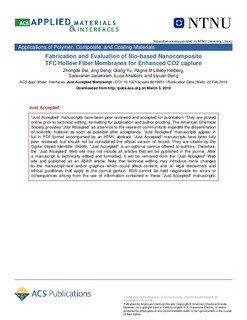| dc.description.abstract | Nanocellulose is a promising and sustainable biobased nanomaterial because of its excellent mechanical properties, biocompatibility, natural abundance, and especially its high aspect ratio. Interest in applying nanocellulose as nanofillers in membrane fabrication has been growing rapidly in recent years. In the present work, nanocellulose crystals (CNCs) and nanocellulose fibers (CNFs) were incorporated into polyvinyl alcohol (PVA) to prepare evenly dispersed nanocomposites. The resultant nanocomposite materials containing up to 80 wt % of nanocellulose were coated as defect-free, thin-film-composite selective layers onto hollow fiber membrane substrates via dip-coating for efficient CO2 capture. Thermogravimetric analysis, Fourier-transform infrared, X-ray diffraction, scanning transmission electron microscopy, scanning electron microscopy, and humid mixed gas permeation test were used to evaluate the nanocomposite materials and the membranes. The resultant PVA/CNC nanocomposite membranes exhibit both higher CO2 permeance and CO2/N2 selectivity compared to the PVA/CNF membranes and neat PVA membranes. The addition of CNCs showed more positive effects on the CO2 permeation compared to CNFs. Under optimized conditions, CO2 permeance of 672 GPU with a CO2/N2 selectivity of 43.6 was obtained with a PVA/CNC membrane. Excellent long-term stability of the membrane was also documented within a period of up to 1 year. The interface between the polymer phase and charged CNFs is believed to form fast gas transport channels at the humid state and thus enhances CO2 permeation. | nb_NO |
